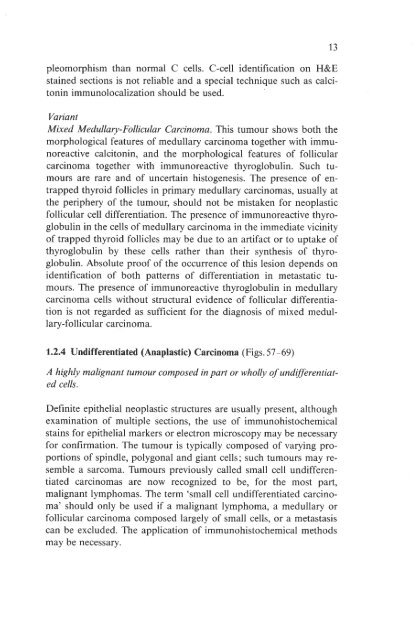Histological Typing of Thyroid Tumours - libdoc.who.int - World ...
Histological Typing of Thyroid Tumours - libdoc.who.int - World ...
Histological Typing of Thyroid Tumours - libdoc.who.int - World ...
You also want an ePaper? Increase the reach of your titles
YUMPU automatically turns print PDFs into web optimized ePapers that Google loves.
73<br />
pleomorphism than normal C cells. C-cell identification on H&E<br />
stained sections is not reliable and a special technique such as calcitonin<br />
immunolocalization should be used.<br />
Variant<br />
Mixed Medullary-Follicular Carcinoma. This tumour shows both the<br />
morphological features <strong>of</strong> medullary carcinoma together with immunoreactive<br />
calcitonin, and the morphological features <strong>of</strong> follicular<br />
carcinoma together with immunoreactive thyroglobulin. Such tumours<br />
are rare and <strong>of</strong> uncertain histogenesis. The presence <strong>of</strong> entrapped<br />
thyroid follicles in primary medullary carcinomas, usually at<br />
the periphery <strong>of</strong> the tumour, should not be mistaken for neoplastic<br />
follicular cell differentiation. The presence <strong>of</strong> immunoreactive thyroglobulin<br />
in the cells <strong>of</strong> medullary carcinoma in the immediate vicinity<br />
<strong>of</strong> trapped thyroid follicles may be due to an artifact or to uptake <strong>of</strong><br />
thyroglobulin by these cells rather than their synthesis <strong>of</strong> thyroglobulin.<br />
Absolute pro<strong>of</strong> <strong>of</strong> the occurrence <strong>of</strong> this lesion depends on<br />
identiflrcation <strong>of</strong> both patterns <strong>of</strong> differentiation in metastatic tumours.<br />
The presence <strong>of</strong> immunoreactive thyroglobulin in medullary<br />
carcinoma cells without structural evidence <strong>of</strong> follicular differentiation<br />
is not regarded as sufficient for the diagnosis <strong>of</strong> mixed medullary-follicular<br />
carcinoma.<br />
1.2.4 Undifferentiated (Anaplastic) Carcinoma (Figs. 57 - 69)<br />
A highly malignant tumour composed in part or <strong>who</strong>lly <strong>of</strong> undffirentiated<br />
cells.<br />
Definite epithelial neoplastic structures are usually present, although<br />
examination <strong>of</strong> multiple sections, the use <strong>of</strong> immunohistochemical<br />
stains for epithelial markers or electron microscopy may be necessary<br />
for confirmation. The tumour is typically composed <strong>of</strong> varying proportions<br />
<strong>of</strong> spindle, polygonal and giant cells; such tumours may resemble<br />
a sarcoma. <strong>Tumours</strong> previously called small cell undifferentiated<br />
carcinomas are now recognized to be, for the most part,<br />
malignant lymphomas. The term 'small cell undifferentiated carcinoma'<br />
should only be used if a malignant lymphoma, a medullary or<br />
follicular carcinoma composed largely <strong>of</strong> small cells, or a metastasis<br />
can be excluded. The application <strong>of</strong> immunohistochemical methods<br />
may be necessary.
















